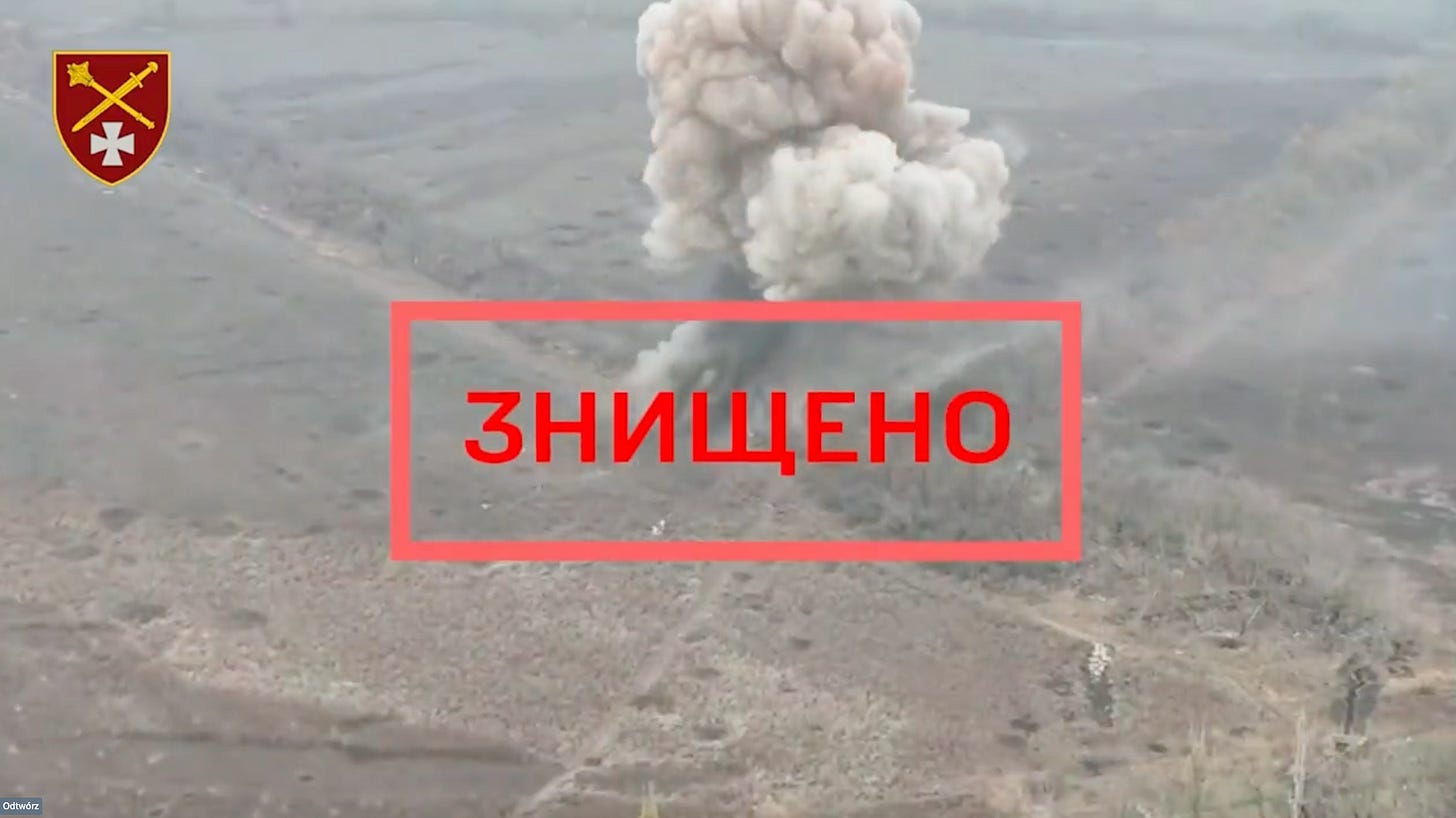The CCTV video surfaced today showing that indeed the KARAKURT Class corvette was destroyed in the Ukrainian attack on the docks in Kerch Shipyard:
Hitting this kind of vessel, let us remind You - one of the ships from the brand new line of warships operating for the Russian Navy is a major hit. And it's not the first one when it comes to limiting the Russian Black Sea fleet's operational capabilities.
Those frontline shots:
are not of strategic meaning, but still its good to sea some Ruzzkiy mines being blown up by the Ukrainians. This one is simply described as “Southern Ukraine”. The target? Russian anti-tank landmines.
Anton Geraschchenko, a Ukrainian Interior Ministry advisor, shared a video showing how the city of AVDIIVKA, a place that we talked about several times and shared some drone footage of this city, looks like from the ground perspective after the Russians were forced out of the city by Ukrainian forces. “BASTARDS” was Gerashchenko’s comment
As for the frontline situation lately - ISW concentrates in its report on Bakhmut and Zaporizha.
Ukrainian forces conducted counteroffensive operations near Bakhmut and in western Zaporizhia Oblast. The Ukrainian General Staff reported that Ukrainian forces continued offensive operations in the Bakhmut and Melitopol (western Zaporizhia Oblast) directions. A prominent Russian milblogger claimed that Ukrainian forces counterattacked near Krasnohorivka (6km northwest of Avdiivka) between November 3 and November 5, thereby forcing Russian troops to withdraw from part of the railway track in the area. The Russian “Russkiy Legion” (BARS-13) irregular armed formation claimed that Ukrainian forces were successfully pressuring Russian forces near Stepove and the "Tsarska Okhota" restaurant south of Avdiivka.
As we discuss Ukraine fighting Russia and Israel fighting Hamas we show interlinks between those wars. Russian activity is the factor connecting those dots. Looks like Russia is doing a lot to find another place in Europe where it wants to open the frontline that seemed to be closed some time ago. Foreign Affairs magazine writes about Serbia and Kosovo in this article:
In May, Serbia placed its troops on combat alert after ethnic Serbs living in Kosovo clashed with Kosovo police. And then in September, just before the recent mobilization at the border, 30 heavily armed ethnic Serbs attacked a police patrol in Kosovo, leaving four people dead.
What is the meaning of this chokepoint of Europan conflicts map? Foreign affairs points out the reasons for which Russia is interested in amplifying those tensions:
Moscow—which does not recognize Kosovo’s independence—fanned the flames, using information operations to fuel Kosovar-Serbian distrust and to spread hawkish messages that polarize the region along ethnic and religious lines. Russia has also armed Serbia while increasing Serbia’s energy dependence on its companies by providing gas and oil at a sharp discount. Moscow has promised Belgrade that it will block Kosovo from becoming a UN member state. “A big explosion is brewing in the center of Europe,” Russian Foreign Minister Sergei Lavrov said in May. It might have been a boast.
And it's not the first time they play this particular tune. Kosovo was a subject of discussions between NATO and RUSSIA long before the war in Ukraine started. Why? Here is the answer:
Part of why Russia is happy to stoke the historical conflict between Kosovo and Serbia is because doing so stresses NATO resources and undermines U.S. power in Europe. NATO forced Serbia to pull out of Kosovo in 1999, and the alliance has maintained a small peacekeeping force of NATO troops in the latter country ever since. As a result, rising tensions between Kosovo and Serbia test NATO’s staying power in the region. Backing Serbia also gives Russia a foothold in the Balkans. Serbian officials have thanked Russia for its “support for Serbia’s territorial integrity and sovereignty” and have stressed that Moscow’s support is the reason Serbia refuses to impose sanctions on Russia.
It's all simply about engaging the US and NATO in another point that Western powers cannot pretend they do not see…
For Putin, this opening has been a boon. Russia views the Balkans as Europe’s soft underbelly, and Moscow believes that Serbia is its most vulnerable spot. His goal is to turn Moscow into the Balkans’ only reliable conflict negotiator—giving the Kremlin leverage over Western powers. After all, if peace in the Balkans depends on Putin, NATO officials might have to make concessions to Moscow if they want to avoid war. By pushing the Balkans to the brink, he also hopes to show that NATO is a paper tiger and will not act if truly tested. Even if NATO does fight back against Serbia, Putin could still win. By opening another front, the West would have less capacity to help Ukraine.
Ukraine, Hamas, Taiwan.. Kosovo and Serbia. Eastern NATO flank. This is a long list of proxy war frontlines with one common goal: To prove that US is not capable of maintaining the status of world superpower anymore.
If states like Russia/ China, Iran, North Korea and other succeed in this process the Cold War could appear to be sent to overtime.










Since 1991 Russia has been looking for proxy wars to involve the US and NATO and weaken them. The invasion of Ukraine was the most successful for Russia and it brought the rest of the axes of evil together and with another major conflict it will seal the faith of the western powers. If the western powers don't wake up soon and realize what Russia is doing, we will be speaking Russian and Chinese in near future.
Why not Serbia, a nation of weasels (2nd dictionary definition = a deceitful or treacherous person.
"he was a double-crossing weasel"